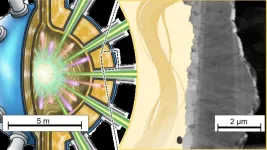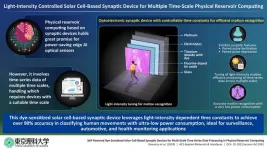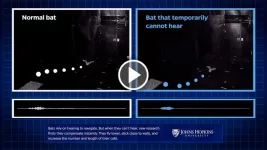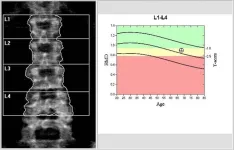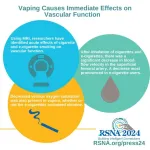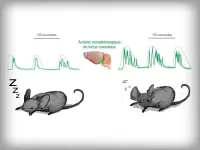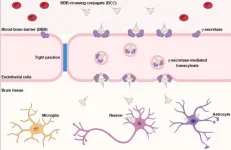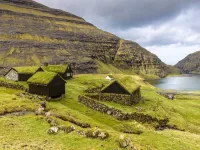(Press-News.org) In a sense, each of us begins life ready for action. Many animals perform amazing feats soon after they’re born. Spiders spin webs. Whales swim. But where do these innate abilities come from? Obviously, the brain plays a key role as it contains the trillions of neural connections needed to control complex behaviors. However, the genome has space for only a small fraction of that information. This paradox has stumped scientists for decades. Now, Cold Spring Harbor Laboratory (CSHL) Professors Anthony Zador and Alexei Koulakov have devised a potential solution using artificial intelligence.
When Zador first encounters this problem, he puts a new spin on it. “What if the genome’s limited capacity is the very thing that makes us so smart?” he wonders. “What if it’s a feature, not a bug?” In other words, maybe we can act intelligently and learn quickly because the genome’s limits force us to adapt. This is a big, bold idea—tough to demonstrate. After all, we can’t stretch lab experiments across billions of years of evolution. That’s where the idea of the genomic bottleneck algorithm emerges.
In AI, generations don’t span decades. New models are born with the push of a button. Zador, Koulakov, and CSHL postdocs Divyansha Lachi and Sergey Shuvaev set out to develop a computer algorithm that folds heaps of data into a neat package—much like our genome might compress the information needed to form functional brain circuits. They then test this algorithm against AI networks that undergo multiple training rounds. Amazingly, they find the new, untrained algorithm performs tasks like image recognition almost as effectively as state-of-the-art AI. Their algorithm even holds its own in video games like Space Invaders. It’s as if it innately understands how to play.
Does this mean AI will soon replicate our natural abilities? “We haven’t reached that level,” says Koulakov. “The brain’s cortical architecture can fit about 280 terabytes of information—32 years of high-definition video. Our genomes accommodate about one hour. This implies a 400,000-fold compression technology cannot yet match.”
Nevertheless, the algorithm allows for compression levels thus far unseen in AI. That feature could have impressive uses in tech. Shuvaev, the study’s lead author, explains: “For example, if you wanted to run a large language model on a cell phone, one way [the algorithm] could be used is to unfold your model layer by layer on the hardware.”
Such applications could mean more evolved AI with faster runtimes. And to think, it only took 3.5 billion years of evolution to get here.
END
The next evolution of AI begins with ours
2024-11-25
ELSE PRESS RELEASES FROM THIS DATE:
Using sunlight to recycle black plastics
2024-11-25
Not all plastics are equal — some types and colors are easier to recycle than others. For instance, black foam and black coffee lids, which are often made of polystyrene, usually end up in landfills because color additives lead to ineffective sorting. Now, researchers report in ACS Central Science the ability to leverage one additive in black plastics, with the help of sunlight or white LEDs, to convert black and colored polystyrene waste into reusable starting materials.
“Simple, visible light irradiation holds the potential to ...
ODS FeCrAl alloys endure liquid metal flow at 600 °C resembling a fusion blanket environment
2024-11-25
Researchers explored protective coatings on advanced to resist corrosion in fusion reactors. They tested α-Al2O3 oxide layers on ODS alloys in a high-temperature, flowing lithium-lead environment. Even bare ODS alloys formed a durable γ-LiAlO2 layer in situ, which suppressed further corrosion. The layers exhibited strong adhesion under mechanical stress, making these findings crucial for improving material durability in fusion reactors and high-temperature energy systems.
Fusion reactors, a promising source of sustainable energy, require advanced materials that can withstand extreme temperatures and corrosive environments ...
A genetic key to understanding mitochondrial DNA depletion syndrome
2024-11-25
Mitochondrial DNA depletion syndrome (MTDPS) is a rare genetic disorder characterized by a marked decrease in mitochondrial DNA (mtDNA). This condition can cause symptoms including muscle weakness, fatigue, and neurological issues, particularly affecting the liver and brain in cases of hepatocerebral MTDPS. Mitochondrial diseases, which represent some of the most common types of metabolic disorders, can result in the failure of multiple organ systems. Currently, over 400 genes linked to these diseases have been identified. Notably, many of these genes are associated with the mitochondrial contact site and cristae ...
The future of edge AI: Dye-sensitized solar cell-based synaptic device
2024-11-25
Artificial intelligence (AI) is becoming increasingly useful for the prediction of emergency events such as heart attacks, natural disasters, and pipeline failures. This requires state-of-the-art technologies that can rapidly process data. In this regard, reservoir computing, specially designed for time-series data processing with low power consumption, is a promising option. It can be implemented in various frameworks, among which physical reservoir computing (PRC) is the most popular. PRC with optoelectronic artificial synapses (junction structures that permit a nerve cell to transmit an electrical or chemical signal to another cell) that mimic human ...
Bats’ amazing plan B for when they can’t hear
2024-11-25
When bats can’t hear, new research finds that these hearing-dependent animals employ a remarkable compensation strategy.
They adapt immediately and robustly, suggesting for the first time that bats’ brains are hard-wired with an ability to launch a Plan B in times of diminished hearing.
The Johns Hopkins University work, newly published in Current Biology, raises questions about whether other animals and even humans might be capable of such deft accommodations.
“Bats have this amazing flexible adaptive behavior that they can employ anytime,” said senior author ...
Common thyroid medicine linked to bone loss
2024-11-25
CHICAGO – Levothyroxine, the second most commonly prescribed medication among older adults in the U.S., may be associated with bone loss, according to a study being presented next week at the annual meeting of the Radiological Society of North America (RSNA).
Levothyroxine, marketed under multiple brand names including Synthroid, is a synthetic version of a hormone called thyroxine and is commonly prescribed to treat the condition hypothyroidism, or underactive thyroid. In people with hypothyroidism, the thyroid gland does not produce enough thyroxine on its own, often resulting in fatigue, weight gain, hair loss and other symptoms. If left untreated, hypothyroidism ...
Vaping causes immediate effects on vascular function
2024-11-25
CHICAGO – Researchers have identified acute effects of cigarette and e-cigarette smoking on vascular function, even without nicotine. The results of the ongoing research are being presented next week at the annual meeting of the Radiological Society of North America (RSNA).
E-cigarettes, also known as vapes, are battery-operated devices that heat a liquid to produce an aerosol, which is then inhaled into the lungs. Vapes contain significantly fewer chemicals and toxins than are found in tobacco smoke. As a result, e-cigarettes are believed by many to be less harmful than cigarette smoking. Vapes also come in various flavors, making them popular among young people.
“E-cigarettes ...
A new clock to structure sleep
2024-11-25
Researchers at the University of Lausanne have identified a novel role for the brain’s ‘locus coeruleus’ in sleep and its disruptions. This brain region facilitates the transition between NREM and REM sleep states while maintaining an unconscious vigilance toward the external world. Stress disrupts its functions and negatively impacts on sleep quality.
Sleep disorders affect an increasing number of people, with potentially serious consequences for their health. Mammalian sleep consists of cycles between two states: non-rapid eye movement (NREM) sleep and rapid eye ...
Study reveals new way to unlock blood-brain barrier, potentially opening doors to treat brain and nerve diseases
2024-11-25
New York, NY [November 25, 2024]—Researchers at the Icahn School of Medicine at Mount Sinai have developed an innovative approach—demonstrated in mouse models and isolated human brain tissue—to safely and effectively deliver therapeutics into the brain, providing new possibilities for treating a wide range of neurological and psychiatric diseases.
Published in the November 25 online issue of Nature Biotechnology [https://doi.org/10.1038/s41587-024-02487-7], the study introduces a first-of-its-kind blood-brain barrier-crossing conjugate (BCC) system, designed to overcome the protective barrier that typically blocks large biomolecules from ...
Viking colonizers of Iceland and nearby Faroe Islands had very different origins, study finds
2024-11-25
The ancient Vikings certainly had the travel bug. Between the late eighth century and approximately 1050 CE, they roamed the Atlantic in their longships all the way to Newfoundland, Labrador, and Greenland, as well as exploring the Mediterranean and continental Eurasia.
Among the places the Vikings are known to have settled were the Faroe Islands, an archipelago of 18 islands in the North Atlantic. They probably weren’t the first to do so: archaeologists have found evidence that these islands had been inhabited since approximately 300 CE, possibly ...

